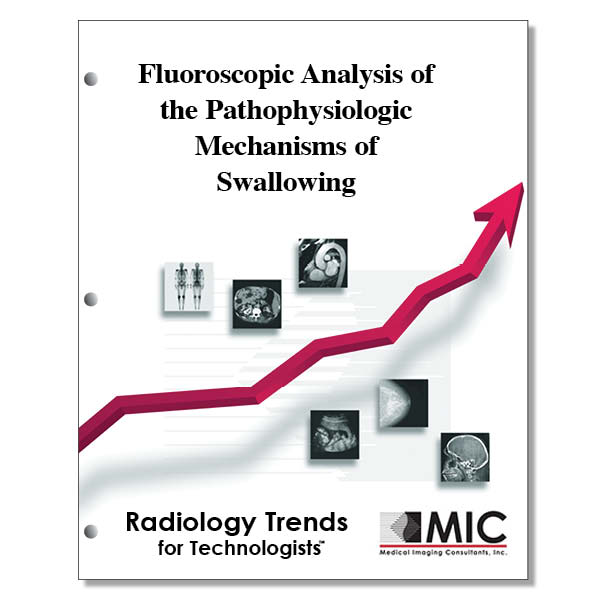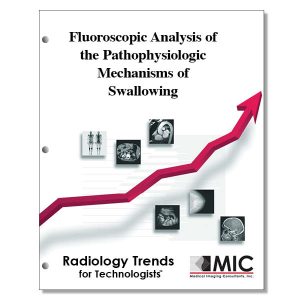

Fluoroscopic Analysis of the Pathophysiologic Mechanisms of Swallowing
The anatomy and physiology of swallowing is reviewed, the indications for and techniques of fluoroscopic examinations are explained, and pathophysiologic mechanisms are discussed.
Course ID: Q00708 Category: Radiology Trends for Technologists Modality: Radiography3.00 |
Satisfaction Guarantee |
$34.00
- Targeted CE
- Outline
- Objectives
Targeted CE per ARRT’s Discipline, Category, and Subcategory classification:
Radiography: 3.00
Procedures: 3.00
Thorax and Abdomen Procedures: 3.00
Registered Radiologist Assistant: 3.00
Procedures: 3.00
Abdominal Section: 3.00
Outline
- Introduction
- Anatomy for Radiographic Interpretation
- Phases of Swallowing
- Oral Preparatory Phase
- Oral Propulsory Phase
- Initiation of Pharyngeal Swallow
- Pharyngeal Phase
- PES Opening Phase
- Esophageal Phase
- Indications for Fluoroscopic Swallowing Examinations
- Fluoroscopic Swallowing Examination Technique
- Functional Abnormalities
- Abnormalities of Oral Preparatory phase
- Premature Spillage from Mouth into Pharynx
- Delayed or Slow Oral Propulsory Phase
- Delayed Initiation of Pharyngeal Swallow
- Nasal Regurgitation
- Slow or Incomplete Displacement of HLC
- Weakness of Tongue and Pharyngeal Contraction
- Lack of Synchronization of Pharyngeal Contractions
- Limited tilt of Epiglottis
- Delayed or Incomplete Laryngeal Closure
- Incomplete Opening of PES
- Delayed Opening of PES
- Early Closure of PES
- Residue in Valleculae and Pyriform Sinuses after Swallowing
- Penetration
- Aspiration
- Anatomic Abnormalities
- Radiography of the Neck
- Pharyngeal Strictures
- Zenker Diverticula
- Killian-Jamieson Diverticula
- Complications of Total Laryngectomy
- Surgical Technique
- Anastomotic Leakage
- Pseudoepiglottis
- Anterior Pharyngeal Pouches
- Neopharyngeal Dysmotilities
- Dysfunctions of PES
- Benign Strictures
- Complications of Tracheoesophageal Fistula and Prosthesis
- Conclusion
Objectives
Upon completion of this course, students will:
- state the prevalence of oropharyngeal dysphagia in the United States
- choose the most used technique for evaluation of deglutition disorders
- list the healthcare professionals that take part in modified barium swallow procedures
- describe how the oral cavity is bounded
- give the alternate name for the laryngopharynx
- describe the oral preparatory phase
- understand when a bolus is “swallowable”
- describe the oral propulsory phase of swallowing
- list the steps in the initiation of the pharyngeal swallow
- list the steps in the pharyngeal phase of swallowing
- know the process of laryngeal closure
- describe the steps in the pharyngoesophageal segment opening phase
- note the swallowing phase in which esophageal peristalsis takes place
- list the common indications for fluoroscopically guided swallowing examinations
- list the equipment capabilities needed for fluoroscopic swallowing examinations
- describe the patient position for fluoroscopic swallowing examinations
- describe the views utilized during fluoroscopic swallowing examinations
- choose the proper technical settings for fluoroscopic swallowing examinations
- list the types of contrast agents used for fluoroscopic swallowing examinations
- explain the personnel required to perform a modified barium swallow examination
- explain the role of the speech-language pathologist for modified barium swallow examinations
- describe the importance of the tongue during the oral preparatory phasel
- ist the causes of tongue failure during the oral preparatory phase
- choose the anatomy that forms the glossopalatal seal
- understand what diseases may cause repetitive unsuccessful attempts to swallow a bolus
- list the causes of delayed swallowing initiation
- describe the function of the hyolaryngeal complex
- describe what is required to increase intrabolus pressure and propel the bolus into the esophagus
- discuss risks of improper pharyngeal contraction
- describe the role of the epiglottis during swallowing
- explain why the pharyngoesophageal segment is normally closed
- list the necessary actions for opening of the pharyngoesophageal segment
- describe how radiologists should evaluate the function of the pharyngoesophageal segment
- recall how much contrast material should remain in the pharyngeal lumen after swallowing
- describe the complications of aspiration
- explain why external-beam radiation affects swallowing
- define radiation strictures
- define cervical esophageal tumors
- describe Zenker diverticula
- explain the development of Zenker diverticula
- list the risk factors for anastomotic leakage
- define pseudoepiglottis
- describe how dysfunctions of the pharyngoesophageal
- segment should be evaluated
